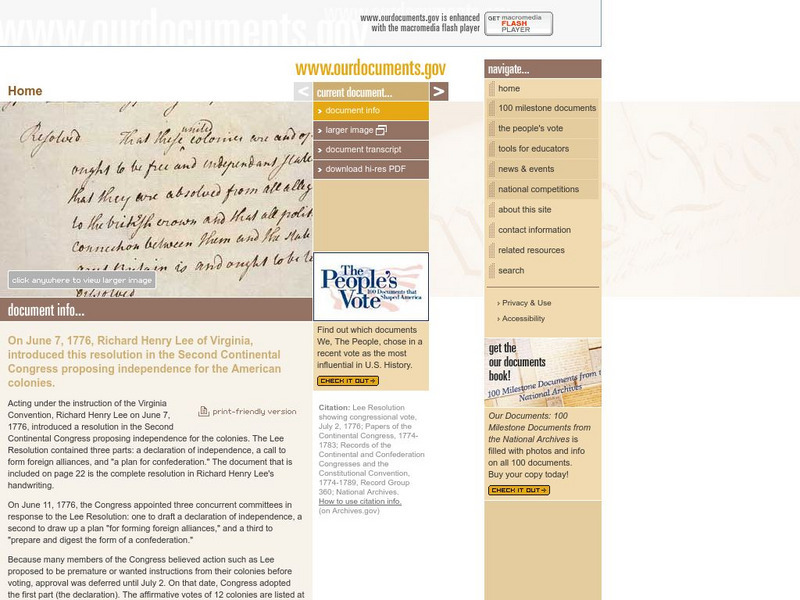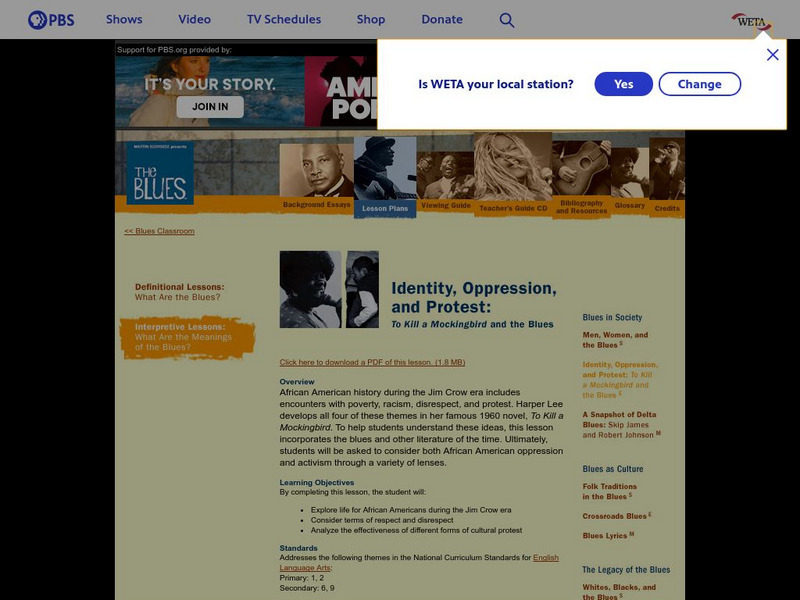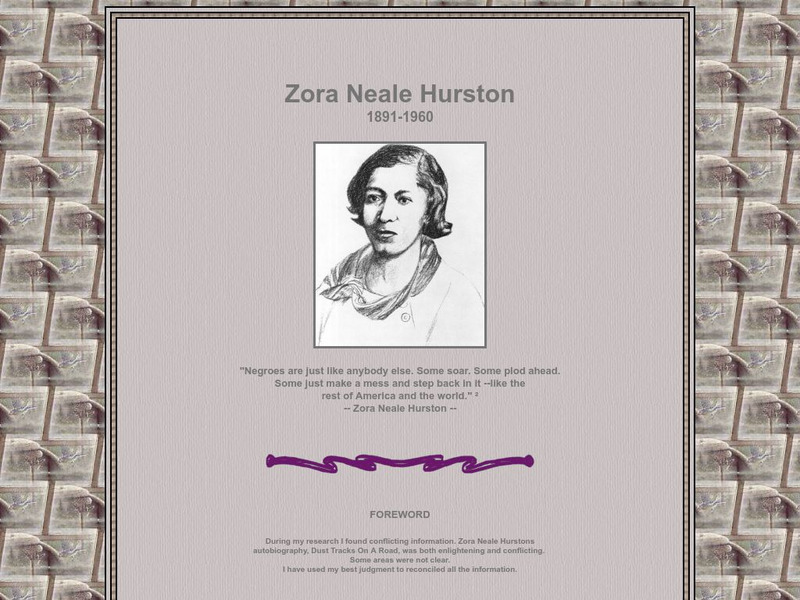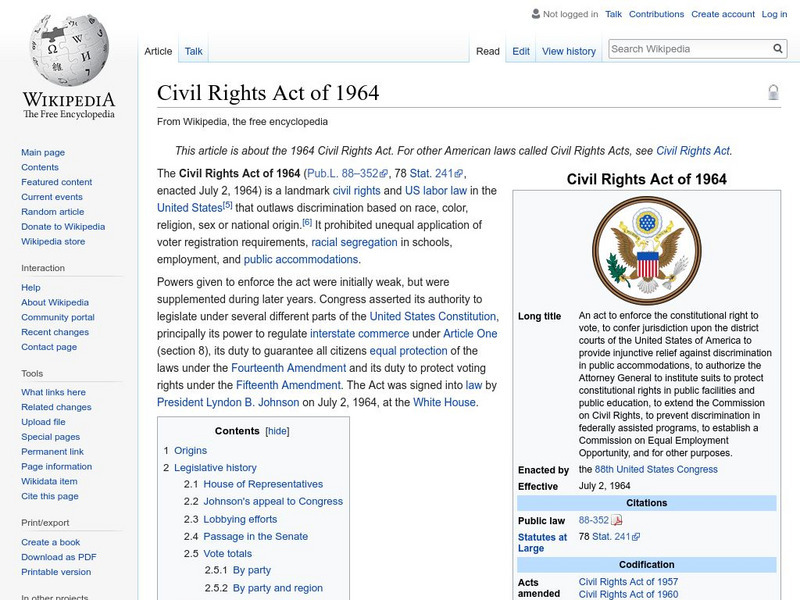US National Archives
Our Documents: Plessy v. Ferguson (1896)
Learn about this landmark Supreme Court case on the issue of racial discrimination . Provides an image of a document from the case files and a transcript of the opinion delivered in 1896 by Justice Henry Brown "which sustained the...
PBS
Pbs: Identity, Oppression, and Protest
This lesson plan supplements a study of Harper Lee's To Kill a Mockingbird. The instructional activity is designed to help students understand the impact of Jim Crow Laws and their impact of oppression on African Americans. Blues music...
University of Missouri
Exploring Constitutional Conflicts: Plessy v Ferguson
Read the Supreme Court opinion that solidified the concept of separate, but equal in American law. The dissenting opinion written by Justice John Harlan is also included.
Other
Fair Vote: X's and O's: A History of the Voting Rights Act and African Americans
Documented essay on the history of black suffrage in American and the significance of the Voting Rights Act of 1965.
Other
American Collection: Zora Neale Hurston
A variety of teacher resource activities are available on this site such as an essay writing activity, debate activity, discussion activity, plus more. A thorough biography on the life of Hurston is also provided.
CommonLit
Common Lit: Book Pairings: "Roll of Thunder, Hear My Cry" by Mildred D. Taylor
Selected (8) reading passages (grades 6-10) to pair with "Roll of Thunder, Hear My Cry" by Mildred D. Taylor. Roll of Thunder, Hear My Cry tells the story of the Logan family combating racial tension and segregation in Mississippi during...
Digital History
Digital History: Discrimination in Public Accommodations [Pdf]
Segregation and Jim Crow laws codified a color line in the United States. African-Americans began pushing back against segregation in the 1950s and 1960s. Read about the non-violent actions taken and how these actions resulted in the...
New York Public Library
In Motion: African American Migration Experience: Migration to Oklahoma
Part of a larger site highlighting African-American migration, this site focuses on successful African-American settlements in Oklahoma Territory, which declined after Oklahoma statehood and the introduction of Jim Crow laws.
Texas State Library and Archives Commission
Texas State Library and Archives Commission: The 1890s: End of an Era and the Quest for Civil Rights
Part of an online exhibit called "Forever Free," this section deals with African Americans' efforts to establish themselves in society, despite increases in racism. Addresses topics such as Black Codes, Jim Crow Laws, and voting rights.
Khan Academy
Khan Academy: Ap Us History: 1844 1877: Reconstruction: The Compromise of 1877
Discusses the Compromise of 1877 which gave the presidency to Rutherford B. Hayes and signaled the end of Reconstruction in the South. As a result of this act, federal troops withdrew from the South, and Jim Crow laws were passed by...
Khan Academy
Khan Academy: Ap Us History: 1865 1898: The Compromise of 1877
Explains how the Compromise of 1877 settled the contested 1876 presidential election, declaring Rutherford B. Hayes the winner while agreeing to withdraw federal troops from the South. This paved the way for the South to enact Jim Crow...
Texas State Library and Archives Commission
Texas State Library and Archives Commission: Texas Joins the Battle: African American Women, 1890s
See photos that are representative of the lives of African-American women at the turn of the century and read about the discrimination black women and men faced: Jim Crow laws, poll taxes, and the "white primary" rule. A brief...
Library of Congress
Loc: Protection of the American Citizen
Around 1877, there was a rise in segregation and obstacles were imposed to keep African Americans from voting. Bishop B.W. Arnett spoke out against these laws in a pamphlet entitled "The Black Laws". Read the entire pamphlet or select...
Digital History
Digital History: Freedom Now
When four African American North Carolina Agricultural and Technical College students refused to leave the lunch-counter at the F.W. Woolworth store in Greensboro they started the first non-violent, "sit-in" movement. Although the...
Varsity Tutors
Varsity Tutors: Web English Teacher: Zora Neale Hurston
This site provides information and activities focused around Zora Neale Hurston's life and work. Check out this site featuring links to several sites focused on Hurston's work.
Ducksters
Ducksters: Civil Rights for Kids: Birmingham Campaign
Kids learn about the history of the Birmingham Campaign that was part of the Civil Rights movement for African Americans against segregation and southern Jim Crow laws on this light.
Digital History
Digital History: The Progressive Era
A good overview of the many social and economic changes that occurred in the United States in the early 20th century. There are hyperlinks to information about the many social reforms, the sad state of race relations at the time, and the...
Read Works
Read Works: Civil Rights on a City Bus
[Free Registration/Login Required] Students read about Rosa Parks and her non-violent protest of segregation laws in the South. A question sheet is available to help students build skills in reading comprehension.
Digital History
Digital History: Plessy v. Ferguson
A very thorough explanation of the famous Supreme Court decision about Plessy v. Ferguson. It upheld the idea of "separate but equal," which was in effect until Brown v Board of Education in 1954. See who opposed the decision, and read...
Wikimedia
Wikipedia: Civil Rights Act of 1964
This is a detailed explanation as to what the Civil Rights Act of 1964 was, how it came about, and how it affected American society. Includes a photograph of President Lyndon Johnson signing the Civil Rights Act into law.
Scholastic
Scholastic: The Progresssive Era
This Grolier On-line Encyclopedia article hits the main points of the Progressive Era stretching from the 1890s until just after the end of World War I.



















